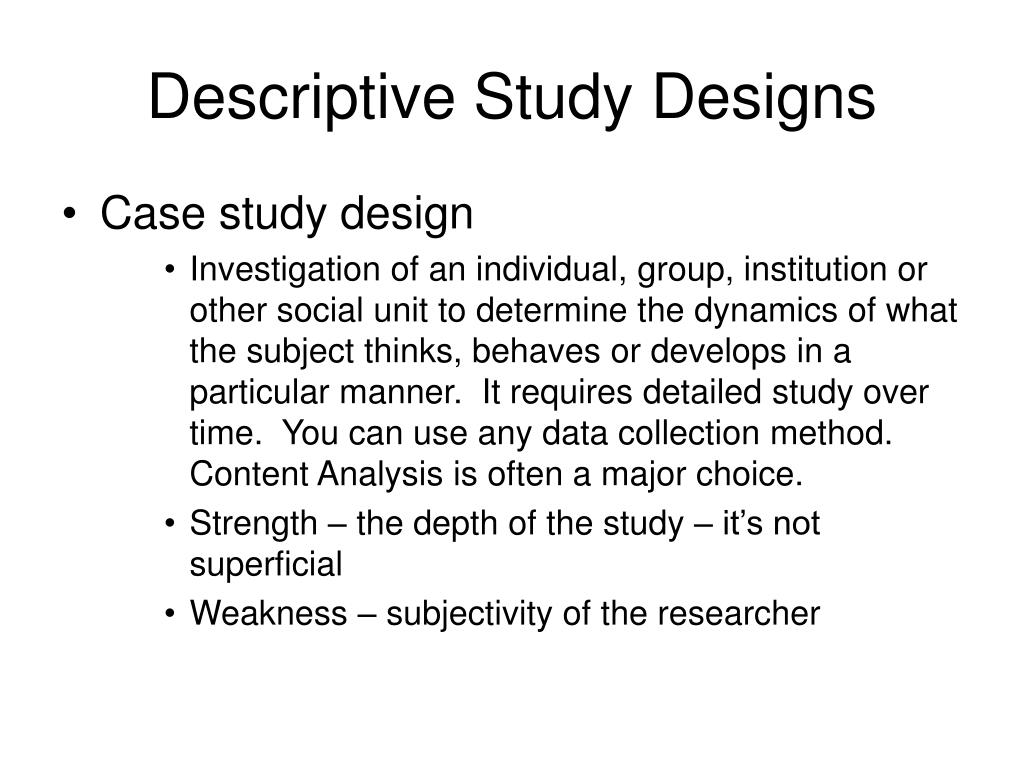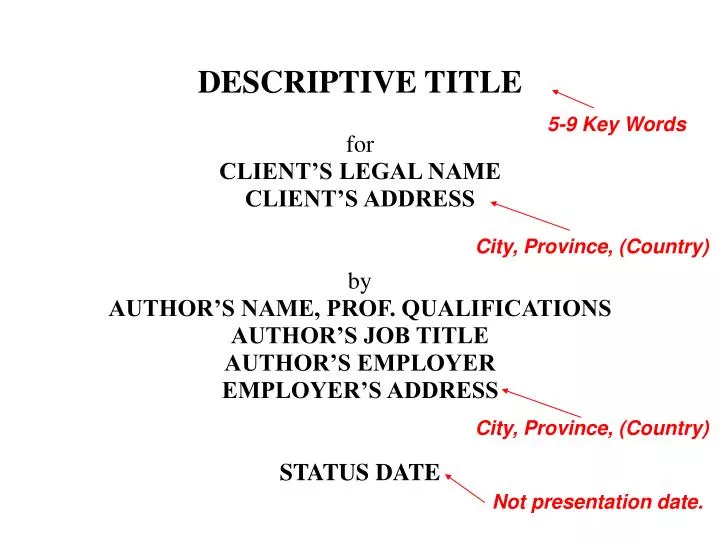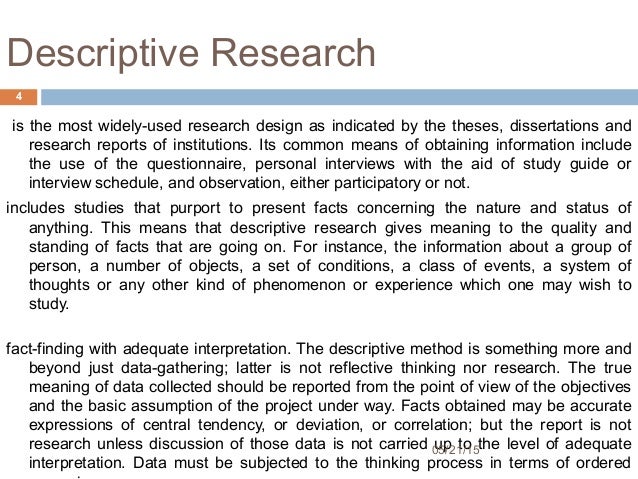Table Of Content

Countries have implemented Return to Practice Programs designed for inactive nurses, each varying in educational content and duration [e.g., 6, 7], and these initiatives have demonstrated notable success in augmenting the nursing labor force [8,9,10,11]. A descriptive research study is a type of observational research and is used for exploring and documenting the nature and scope of a problem, identifying its trends and patterns, and providing a basis for subsequent research. The outcome of a descriptive study is helpful in making decisions, developing policies, and planning social programs.
What is descriptive research design?

Inferential research uses statistical techniques to estimate population parameters, test hypotheses, and determine the level of confidence or significance in the findings. It examines the data critically, applies statistical techniques or other analytical methods, and draws conclusions based on the discovery. Analytical research also aims to explore the relationships between variables and understand the underlying mechanisms or processes involved. There are 3 main data collection methods in descriptive research, namely; observational method, case study method, and survey research.
Risk of sampling error
The descriptive method of research can be used to measure changes in variables over a period of time, allowing trends to be identified and analyzed. It is important to note that in the descriptive research method, the researcher does not control or manipulate any variables, unlike in experimental research. Descriptive research is often used as a pre-cursor to quantitative research designs, the general overview giving some valuable pointers as to what variables are worth testing quantitatively. Quantitative experiments are often expensive and time-consuming so it is often good sense to get an idea of what hypotheses are worth testing. Data analysis involves using various methodologies, enabling the researcher to evaluate and provide results regarding validity and reliability.
Data analysis
Perhaps linked to the practical application of pragmatism to research, that is, applying the best methods to answer the research question, is the classification of qualitative descriptive research by Sandelowski (2010, p. 82) into a ‘distributed residual category’. This recognises and incorporates uncertainty about the phenomena being studied and the research methods used to study them. For researchers, it permits the use of one or more different types of inquiry, which is essential when acknowledging and exploring different realities and subjective experiences in relation to phenomena (Long et al., 2018).
The case study could involve interviews with the owners of the business, observation of their business practices, and analysis of their financial data to document the costs and benefits of sustainability initiatives. It involves gathering information that can be used to rate the effectiveness and worthwhileness of a program or policy, or institution. They are also popularly used in market research to collect customer feedback to optimize products and strategies and improve customer experience (CX). Some popular market research surveys are Net Promoter Score® (NPS®) surveys, brand tracking surveys, and conjoint analysis surveys. Descriptive research can prove to be a useful tool when trying to test the validity of an existing condition as it involves conducting an in-depth analysis of every variable before drawing conclusions.
This serves to not only provide information and guidance for researchers, but to ensure acceptable standards in how this approach is applied in healthcare research. The findings of this study suggest that in order to retain returners in the current nursing force, it is imperative to maximize both the enablers and motivators that contribute to the sustainability and enrichment of their personal and professional lives. In order to maximize the enablers, the establishment of a family-friendly environment is crucial.
Web Developer Responsibilities, Skills, and Salary - Spiceworks Inc - Spiceworks News and Insights
Web Developer Responsibilities, Skills, and Salary - Spiceworks Inc.
Posted: Thu, 13 Oct 2022 07:00:00 GMT [source]

Students who are more proficient in mathematics will be encouraged to go into STEM and vice versa. Institutions may also use this data to identify students’ weak points and work on ways to assist them. An academic institution may wish 2 compare the performance of its junior high school students in English language and Mathematics. This may be used to classify students based on 2 major groups, with one group going ahead to study while courses, while the other study courses in the Arts & Humanities field. This is mainly because it is important to have a proper understanding of what a research problem is about before investigating why it exists in the first place. There are various descriptive research types, each suited to different research objectives.
How does descriptive research compare to qualitative research?
Using descriptive research, researchers will use surveys to understand who voters are more likely to choose out of the parties or candidates available. When conducting descriptive research it’s important that the initial survey questions are properly formulated. For example, if you want to understand the fashion trends we mentioned earlier, you would set up a study in which a researcher observes people in the respondent’s natural environment to understand their habits and preferences. This is because researchers aim to gather data in a natural setting to avoid swaying respondents.
Descriptive research examples
O’Reilly and Parker (2012) question the appropriateness of the rigid application of saturation as a sample size measure arguing that outside of Grounded Theory, its use is inconsistent and at times questionable. Malterud et al. (2016) focus instead on the concept of ‘information power’ to determine sample size. Here, they suggest sample size is determined by the amount of information the sample holds relevant to the actual study rather than the number of participants (Malterud et al., 2016). Some guidance on specific sample size depending on research design has been provided in the literature; however, these are sometimes conflicting and in some cases lack evidence to support their claims (Guest et al., 2006). This is further complicated by the range of qualitative designs and data collection approaches available.
It goes beyond description and aims to understand the reasons or factors that influence a particular outcome or behavior. Explanatory research involves analyzing data, conducting statistical analyses, and developing theories or models to explain the observed relationships. Descriptive research typically involves collecting and analyzing quantitative or qualitative data to generate descriptive statistics or narratives. Exploratory research differs from descriptive research because it aims to explore and gain firsthand insights or knowledge into a relatively unexplored or poorly understood topic.
The first step is to identify and outline the objectives of your research and then translate these objectives into criteria of investigation. You must clearly identify the different issues and questions in the context of which the knowledge of the situation must be surveyed. A census survey is a kind of survey where information is gathered from all units of a population. Data collected through a census study is highly generalizable to the population as all or most units of the population are sampled.
Among those with myopia at the time of the initial survey, 49.2% showed progression of myopia with a mean change of −0.27 ± 0.42 D. Consider a researcher working on climate change adaptation, who wants to understand water management trends in an arid village in a specific study area. She must conduct a demographic survey of the region, gather population data, and then conduct descriptive research on this demographic segment. The study will then uncover details on “what are the water management practices and trends in village X.” Note, however, that it will not cover any investigative information about “why” the patterns exist. The nursing shortage is a persistent issue that is anticipated to worsen in the foreseeable future. The available solutions to alleviate this problem are limited, and a cost-effective approach involves incentivizing inactive nurses to rejoin the nursing workforce [60].
Furthermore, overall, 322 (3.3%), 247 (2.5%) and 3 children had mild, moderate, and severe visual impairment, respectively. These parts of the study looked at the prevalence and degree of myopia or of visual impairment, and did not assess the relationship of one variable with another or test a causative hypothesis – these qualify as a descriptive cross-sectional study. These data would be helpful to a health planner to assess the need for a school eye health program, and to know the proportion of children in her jurisdiction who would need corrective glasses. Descriptive research explores research problems in-depth, beyond the surface level thereby giving a detailed description of the research subject. Descriptive research typically involves analyzing data to generate descriptive statistics, such as means, frequencies, or percentages, to describe the characteristics or behaviors observed. A random sample of potential participants of the test may be asked to use the 2 different methods, and factors like failure rates, time factors, and others will be evaluated to arrive at the best method.


No comments:
Post a Comment